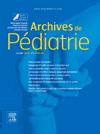Reference values for liver stiffness in children using shear-wave elastography
IF 1.3
4区 医学
Q3 PEDIATRICS
引用次数: 0
Abstract
Background
Ultrasound shear wave elastography (SWE) measures liver stiffness non-invasively in chronic liver diseases. Reference values in healthy children by age are needed in clinical practice.
Objectives
Our study aimed to measure the reference values for liver elasticity by 2D SWE in a pediatric population stratified by age.
Materials and methods
This retrospective study included 266 children without liver disease referred for an abdominal or renal ultrasonography from February 2022 to April 2022. Shear wave elasticity and shear wave speed were measured with a convex (6C1) or linear (SL15–4) transducer with a Canon Aplio 500 Aplio system performed for another reason in healthy children aged 0 to 19 years distributed in five age groups.
Results
Median liver elasticity value was 5.50 kPa (interquartile range [IQR] 4.9–6.3) overall. Global analyses revealed values decreasing with increasing age from newborn to adolescence (elasticity: 6.0 kPa [IQR 5.4–6.5] to 5.3 kPa [IQR 4.7–6.4]; speed: 1.41 m/s [IQR 1.34–1.47] to 1.33 m/s [IQR 1.27–1.46], p < 10–3). Elasticity values were lower with the convex than linear transducer (5.20 kPa [IQR 4.7–5.8] vs 6.2 kPa [IQR 5.6–6.6], p < 10–4). Elasticity values increase with increasing age if we study each probe individually (from 1 year old to older). Median elasticity values were not associated with sex after adjustment for age or with BMI.
Conclusion
Our study provides reference values for liver elasticity in healthy children by age and for two probes using an Aplio system. Liver elasticity values differed according to the probe used.
用剪切波弹性成像测量儿童肝脏硬度的参考值。
背景:超声剪切波弹性成像(SWE)在慢性肝病中无创测量肝脏硬度。临床需要按年龄划分的健康儿童的参考值。目的:我们的研究旨在通过2D SWE在按年龄分层的儿科人群中测量肝脏弹性的参考值。材料和方法:本回顾性研究包括266名无肝脏疾病的儿童,于2022年2月至2022年4月进行腹部或肾脏超声检查。横波弹性和横波速度用凸(6C1)或线性(SL15-4)换能器和佳能Aplio 500 Aplio系统测量,在分布在五个年龄组的0至19岁的健康儿童中进行。结果:肝脏弹性中位数为5.50 kPa(四分位间距[IQR] 4.9-6.3)。全球分析显示,从新生儿到青春期,弹性值随着年龄的增加而降低(弹性:6.0 kPa [IQR 5.4-6.5]至5.3 kPa [IQR 4.7-6.4];速度:1.41 m/s [IQR 1.34-1.47] ~ 1.33 m/s [IQR 1.27-1.46], p < 10-3)。与线性换能器相比,凸形换能器的弹性值较低(5.20 kPa [IQR 4.7-5.8] vs 6.2 kPa [IQR 5.6-6.6], p < 10-4)。如果我们单独研究每个探针(从1岁到更大),弹性值随着年龄的增长而增加。调整年龄或BMI后,中位弹性值与性别无关。结论:本研究为不同年龄的健康儿童的肝脏弹性提供了参考价值,并为两种探针的应用提供了参考价值。肝弹性值因所用探针不同而不同。
本文章由计算机程序翻译,如有差异,请以英文原文为准。
求助全文
约1分钟内获得全文
求助全文
来源期刊

Archives De Pediatrie
医学-小儿科
CiteScore
2.80
自引率
5.60%
发文量
106
审稿时长
24.1 weeks
期刊介绍:
Archives de Pédiatrie publishes in English original Research papers, Review articles, Short communications, Practice guidelines, Editorials and Letters in all fields relevant to pediatrics.
Eight issues of Archives de Pédiatrie are released annually, as well as supplementary and special editions to complete these regular issues.
All manuscripts submitted to the journal are subjected to peer review by international experts, and must:
Be written in excellent English, clear and easy to understand, precise and concise;
Bring new, interesting, valid information - and improve clinical care or guide future research;
Be solely the work of the author(s) stated;
Not have been previously published elsewhere and not be under consideration by another journal;
Be in accordance with the journal''s Guide for Authors'' instructions: manuscripts that fail to comply with these rules may be returned to the authors without being reviewed.
Under no circumstances does the journal guarantee publication before the editorial board makes its final decision.
Archives de Pédiatrie is the official publication of the French Society of Pediatrics.
 求助内容:
求助内容: 应助结果提醒方式:
应助结果提醒方式:


